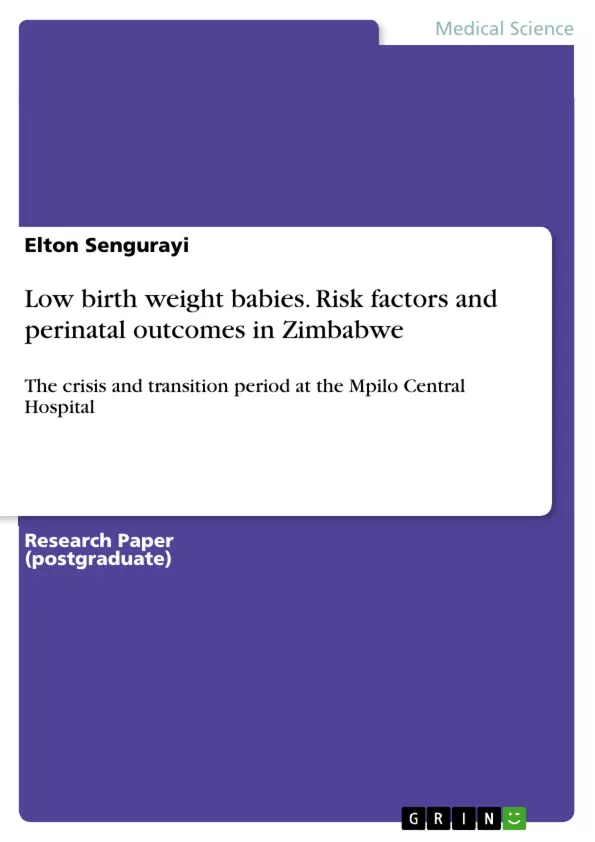The purpose of our study is to evaluate the role of several maternal factors that would contribute to low birth weight (LBW) and to what extend they would affect the birth weight. The main objectives is to look at the LBW incidence, risk factors and immediate perinatal outcomes from 2008-2009 in Zimbabwe and make a comparison with normal weight babies. In addition, it tries to illustrate any relationship between LBW and the several suspected contributing factors to immediate outcome (fetal condition on delivery).
Low birth weight (LBW) has been defined by the World Health Organization (WHO) as weight at birth less than 2 500 grams (5.5 pounds). This practical cut-off for international comparison is based on epidemiological observations that infants weighing less than 2 500 g are approximately 20 times more likely to die than heavier babies. A birth weight below 2 500 g contributes to a range of poor health outcomes and this is more common in developing than developed countries.
According to the 2002 census, Zimbabwe has 11.6 million people. Infant mortality rates (IMR) climbed from 53 to 81 deaths per 1000 from 1960 to 2008. Also 2/3 of childhood deaths occur during infancy, with more than a third taking place during the 1st month of life. Estimates of unemployment rate are around 85-90%. As of 2009, 1.2 million Zimbabweans live with HIV. By end of 2008 the health system had more or less collapsed. Three of Zimbabwe’s four major hospitals (Mpilo was the exception) had shut down, along with University of Zimbabwe’s Medical School.
Table of Contents
- PURPOSE OF THE STUDY.
- OBJECTIVES
- To look at the LBW incidence, risk factors and immediate perinatal outcomes from 2008-2009 and make a comparison with normal weight babies.
- To determine the effect of various maternal factors on LBW.
- To illustrate any relationship between LBW and the several suspected contributing factors to immediate outcome (fetal condition on delivery).
- To measure any association between LBW and other peri-partum conditions and to what extend perinatal outcome was affected by LBW.
- To determine the trends and any differences in birth weights during the year of socio-economic and political turmoil and through the transition thereof (any difference between the 2008 and 2009 figures).
- To identify and quantify risk factors for preterm (<37 gestation) and term LBW (>/= 37 gestation).
- To illustrate any seasonal variation of birth weights through measurement of proportion of LBW to normal birth weights on a month-on-month basis.
- ASSUMPTIONS.
- STUDY POPULATION
- BACKGROUND
- METHODOLOGY
- LIMITATIONS
- RESULTS..
- DISCUSSION.
Objectives and Key Themes
This study aims to evaluate the role of several maternal factors that contribute to low birth weight (LBW) and their impact on birth weight. It also investigates the immediate outcomes associated with LBW and various risk factors involved.
- The prevalence and impact of LBW in the study population.
- Maternal factors influencing LBW.
- The relationship between LBW and perinatal outcomes.
- The effects of socio-economic and political conditions on LBW.
- The identification and quantification of risk factors for preterm and term LBW.
Chapter Summaries
- PURPOSE OF THE STUDY: This chapter outlines the study's objective, which is to assess the role of maternal factors contributing to LBW and their impact on birth weight and perinatal outcomes.
- OBJECTIVES: This chapter defines the specific goals of the study, including examining LBW incidence, risk factors, immediate outcomes, and the effect of various maternal factors on LBW.
- ASSUMPTIONS: This chapter presents the assumptions underpinning the study, including the influence of factors such as unbooked pregnancies, age, parity, HIV status, socio-economic status, and obstetric history on birth weight.
- STUDY POPULATION: This chapter provides demographic information about Zimbabwe, focusing on its population characteristics, socio-economic conditions, and the state of the healthcare system, particularly the impact of the crisis and transition period on healthcare provision.
- BACKGROUND: This chapter discusses the definition of LBW, its significance in global health, and its role in infant mortality and morbidity. The chapter also explores the complexities of LBW, including preterm delivery and intrauterine growth restriction (IUGR), and highlights the need to identify factors contributing to LBW.
Keywords
The study's main focus is on low birth weight (LBW), maternal factors, perinatal outcomes, risk factors, socio-economic conditions, preterm delivery, and intrauterine growth restriction (IUGR). The study analyzes the impact of the crisis and transition period on LBW prevalence and explores the relationship between LBW and infant mortality and morbidity.
- Quote paper
- Elton Sengurayi (Author), 2013, Low birth weight babies. Risk factors and perinatal outcomes in Zimbabwe, Munich, GRIN Verlag, https://www.grin.com/document/539233



